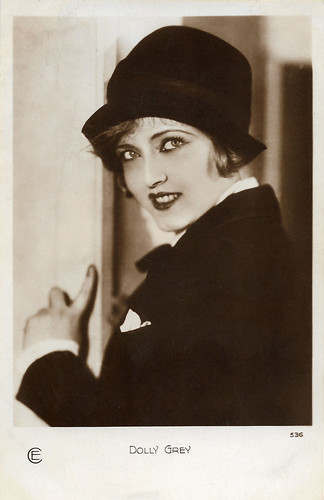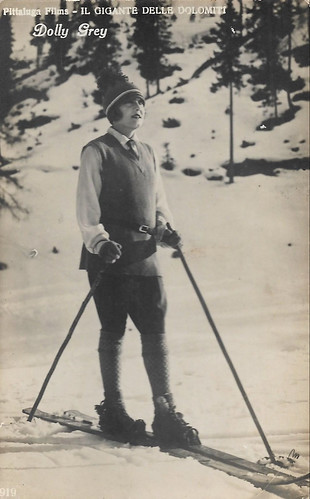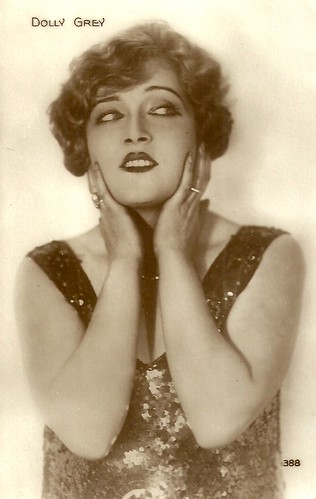Dolly Grey aka Dolly Gray (1904-1958?) was an Italian actress on the silent screen. Her real name was Clara Galassi. Grey acted in Italian and German silent films during the second half of the 1920s. She was film director Guido Brignone's companion after his wife Lola died in 1924 at the age of only 33. Grey would act in two of his films too. There is little information about Grey and her films, so we did some research in the archives and discovered two mysterious films our usual sources missed.

French postcard by Editions Cinémagazine, no. 536.
Dolly Grey was born Clara Galassi in Rome, Italy, in 1904. Her first films were Il focolare spento/The Hearth Off (Augusto Genina, 1925) with Rina De Liguoro, Lido Manetti and Carmen Boni, and Teodoro e socio/Theodore & Co. (Mario Bonnard, 1925) with Marcel Lévesque.
She then acted in the Italian adventure film Saetta e le sette mogli del Pascià/Pasha's Seven Wives (1926) with Domenico Gambino as Saetta. and in the Dutch film Moderne landhaaien/Modern land sharks (Alex Benno, 1926). In 1927 she played the paintress Maud opposite Bartolomeo Pagano aka Maciste in Il gigante delle Dolomiti/The giant of the Dolomites (Guido Brignone, 1927), a mountain drama shot at Cortina d'Ampezzo. It was the last in a series of silent films featuring the Strongman hero Maciste. Grey and director Guido Brignone became a couple and went to Germany.
Grey had an uncredited part in Fritz Lang's Metropolis (1927) as one of the female workers. She also had a small part in the Science Fiction film Der Meister der Welt/The Master of the World (1927) directed by another Italian émigré in Berlin, Gennaro Righelli, and starring Fred Solm, Xenia Desni, and Olga Tschechova.
According to an announcement in the French magazine Cinéa, and according to the Brignone archive at the Film Museum of Turin, Brignone shot at the Studio des Cicognes the comedy Vite!... Embrassez-moi!.../Quick! ... Kiss me! ... (Guido Brignone, 1927) with Dolly Grey, André Roanne, Luigi Serventi, Berthe Jalabert and many others, but IMDb does not mention the film.
What happened? Was the film never released or is IMDb missing something? The Brignone archive lists a censorship date for Italy, which suggests an Italian release. The newspaper Comoedia had an ad in August 1928, indicating the film was shown at the (Parisian?) cinema Impérial but retitled Caprice de femme/Women's Caprice and distributed by Franco-Film. The title Caprice de femme is also absent on IMDb.

Italian postcard by S.A. Stefano Pittaluga, no. 919. Photo: Pittaluga Films. Dolly Grey in Il gigante delle Dolomiti (Guido Brignone, 1927), starring Bartolomeo Pagano aka Maciste.
Caprice de femmes may not have been a huge success, but Dolly Grey and Guido Brignone were able to make another film, Le Retour/The Return (Guido Brignone, 1928), that was apparently co-produced by France and is not mentioned by IMDb. Early announcements indicate that it was a film with Grey, Max Maxudian, André Mattoni and little Cloclo.
Original papers and journals on Gallica (Le Gaullois, la Presse) indicate the film was produced by the Société des Films Artistiques (Sofar) and distributed by Les Films Cosmograph. It must have been the French version or French title of the film listed at IMDb as the German production Marys großes Geheimnis/Mary's Big Secret (Guido Brignone, 1928), produced by Lothar Stark-Film. Filmportal.de also mentions the film, but under the title Aus dem Elternhaus vertrieben (Guido Brignone, 1927-1928).
The film was partly shot in Berlin (the interiors), and partly in Paris (the exteriors). In November 1927, an emotional scene of the film was shot at the Bois de Boulogne, in front of the Parisian press (Figaro, Paris-soir, etc.). In the scene, Max Maxudian is about to declare Grey his love when his grandson Cloclo reminds him that his only love by now should be that of his grandfather.
In the same month, Brignone went to Berlin to shoot the interiors at the EFA Studio. Léo Joannon and Adolf Rosen were his assistant directors, while Gustave Preiss was the cinematographer in France and Akos Farkas (or both) in Germany. When the film came out in France in early 1928, Marcel Lapierre in the socialist journal Le Peuple thought it 'a bit long and ornate', but the critic praised the performances of Grey, Mattoni, Maxudian and little Cloclo. In August 1928, Le Journal praised in particular Maxudian's performance in the film. Le Retour fared better than Caprice de femmes. In 1929, Le Retour was still shown in provincial cinemas in France.
Dolly Grey returned to Berlin for a major part in the German comedy Robert und Bertram/Robert and Bertram (Rudolf Walther-Fein, 1928), featuring Harry Liedtke and Fritz Kampers. Her last role was in the Italian late silent film Maratona/Marathon (Nicola Fausto Neroni, 1929) with Elio Steiner. The ad for the film on IMDb shows that she was still presented as the main star of the film. When we wrote her biography, it was unknown what happened to Dolly Grey after this film nor when or where she died. In 2022, her granddaughter presented a portrait of Dolly by Polish artist Tadeusz (Tade) Styka to the TV show Antiques Roadshow on PBS. She said that at the time of the sitting Dolly had just married her grandfather, who was an engineer at the Marconi House in Paris. She thinks her grandmother passed away in 1954 or 1958.

French postcard by Editions Cinémagazine, no. 388.
Tade Styka Dolly Grey Portrait, ca. 1925 | Best Moment | ANTIQUES ROADSHOW | PBS.
Sources: IMDb, Wikipedia, Filmportal.de, and many original French papers and trade papers at Gallica.
This post was last updated on 14 January 2024.

French postcard by Editions Cinémagazine, no. 536.
The mystery of Caprice de femme
Dolly Grey was born Clara Galassi in Rome, Italy, in 1904. Her first films were Il focolare spento/The Hearth Off (Augusto Genina, 1925) with Rina De Liguoro, Lido Manetti and Carmen Boni, and Teodoro e socio/Theodore & Co. (Mario Bonnard, 1925) with Marcel Lévesque.
She then acted in the Italian adventure film Saetta e le sette mogli del Pascià/Pasha's Seven Wives (1926) with Domenico Gambino as Saetta. and in the Dutch film Moderne landhaaien/Modern land sharks (Alex Benno, 1926). In 1927 she played the paintress Maud opposite Bartolomeo Pagano aka Maciste in Il gigante delle Dolomiti/The giant of the Dolomites (Guido Brignone, 1927), a mountain drama shot at Cortina d'Ampezzo. It was the last in a series of silent films featuring the Strongman hero Maciste. Grey and director Guido Brignone became a couple and went to Germany.
Grey had an uncredited part in Fritz Lang's Metropolis (1927) as one of the female workers. She also had a small part in the Science Fiction film Der Meister der Welt/The Master of the World (1927) directed by another Italian émigré in Berlin, Gennaro Righelli, and starring Fred Solm, Xenia Desni, and Olga Tschechova.
According to an announcement in the French magazine Cinéa, and according to the Brignone archive at the Film Museum of Turin, Brignone shot at the Studio des Cicognes the comedy Vite!... Embrassez-moi!.../Quick! ... Kiss me! ... (Guido Brignone, 1927) with Dolly Grey, André Roanne, Luigi Serventi, Berthe Jalabert and many others, but IMDb does not mention the film.
What happened? Was the film never released or is IMDb missing something? The Brignone archive lists a censorship date for Italy, which suggests an Italian release. The newspaper Comoedia had an ad in August 1928, indicating the film was shown at the (Parisian?) cinema Impérial but retitled Caprice de femme/Women's Caprice and distributed by Franco-Film. The title Caprice de femme is also absent on IMDb.

Italian postcard by S.A. Stefano Pittaluga, no. 919. Photo: Pittaluga Films. Dolly Grey in Il gigante delle Dolomiti (Guido Brignone, 1927), starring Bartolomeo Pagano aka Maciste.
Another mystery: Le Retour
Caprice de femmes may not have been a huge success, but Dolly Grey and Guido Brignone were able to make another film, Le Retour/The Return (Guido Brignone, 1928), that was apparently co-produced by France and is not mentioned by IMDb. Early announcements indicate that it was a film with Grey, Max Maxudian, André Mattoni and little Cloclo.
Original papers and journals on Gallica (Le Gaullois, la Presse) indicate the film was produced by the Société des Films Artistiques (Sofar) and distributed by Les Films Cosmograph. It must have been the French version or French title of the film listed at IMDb as the German production Marys großes Geheimnis/Mary's Big Secret (Guido Brignone, 1928), produced by Lothar Stark-Film. Filmportal.de also mentions the film, but under the title Aus dem Elternhaus vertrieben (Guido Brignone, 1927-1928).
The film was partly shot in Berlin (the interiors), and partly in Paris (the exteriors). In November 1927, an emotional scene of the film was shot at the Bois de Boulogne, in front of the Parisian press (Figaro, Paris-soir, etc.). In the scene, Max Maxudian is about to declare Grey his love when his grandson Cloclo reminds him that his only love by now should be that of his grandfather.
In the same month, Brignone went to Berlin to shoot the interiors at the EFA Studio. Léo Joannon and Adolf Rosen were his assistant directors, while Gustave Preiss was the cinematographer in France and Akos Farkas (or both) in Germany. When the film came out in France in early 1928, Marcel Lapierre in the socialist journal Le Peuple thought it 'a bit long and ornate', but the critic praised the performances of Grey, Mattoni, Maxudian and little Cloclo. In August 1928, Le Journal praised in particular Maxudian's performance in the film. Le Retour fared better than Caprice de femmes. In 1929, Le Retour was still shown in provincial cinemas in France.
Dolly Grey returned to Berlin for a major part in the German comedy Robert und Bertram/Robert and Bertram (Rudolf Walther-Fein, 1928), featuring Harry Liedtke and Fritz Kampers. Her last role was in the Italian late silent film Maratona/Marathon (Nicola Fausto Neroni, 1929) with Elio Steiner. The ad for the film on IMDb shows that she was still presented as the main star of the film. When we wrote her biography, it was unknown what happened to Dolly Grey after this film nor when or where she died. In 2022, her granddaughter presented a portrait of Dolly by Polish artist Tadeusz (Tade) Styka to the TV show Antiques Roadshow on PBS. She said that at the time of the sitting Dolly had just married her grandfather, who was an engineer at the Marconi House in Paris. She thinks her grandmother passed away in 1954 or 1958.

French postcard by Editions Cinémagazine, no. 388.
Tade Styka Dolly Grey Portrait, ca. 1925 | Best Moment | ANTIQUES ROADSHOW | PBS.
Sources: IMDb, Wikipedia, Filmportal.de, and many original French papers and trade papers at Gallica.
This post was last updated on 14 January 2024.
4 comments:
Her granddaughter just valued her portrait at antiques roadshow with more information about her
https://vm.tiktok.com/ZM692VcS1/
Thanks, we've updated the post.
Is Dolly Grey still alive? I can't find a date of death for her!
In 2022, her granddaughter presented a portrait of Dolly by Polish artist Tadeusz (Tade) Styka to the TV show Antiques Roadshow on PBS. She said that at the time of the sitting Dolly had just married her grandfather, who was an engineer at the Marconi House in Paris. She thinks her grandmother passed away in 1954 or 1958. See the embedded video fragment.
Post a Comment